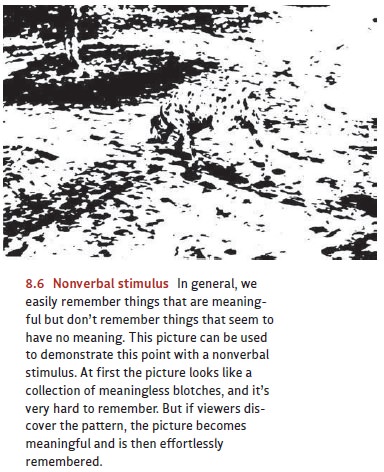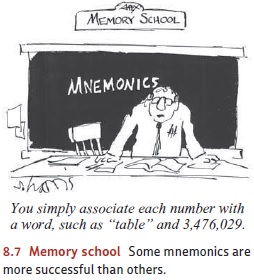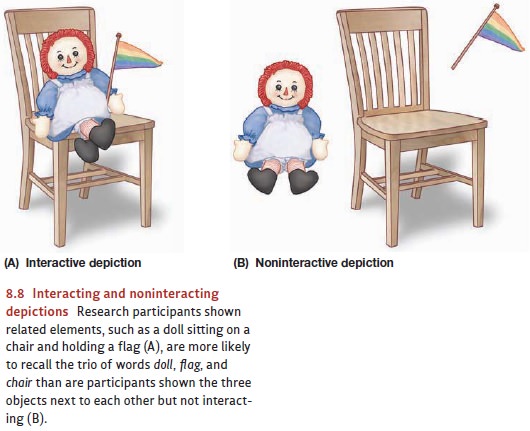Chapter: Psychology: Memory
Acquisition: Establishing Long-Term Memories
Establishing
Long-Term Memories
So far, we’ve argued for a
separation between working memory and long-term memory, and we’re starting to
see indications of each memory’s attributes. Working memory has a small
capacity—although it’s flexible in what it can hold, thanks to the process of
chunking. Long-term memory, in contrast, is vast. After all, the average
college student remembers the meanings of 80,000 words, thousands of
autobiographical episodes, millions of facts, hundreds of skills, the taste of
vanilla and the smell of lemon. All these things and more are stored in
long-term memory.
Working memory and long-term
memory also differ in how they’re “loaded” and “unloaded.” To get information
into working memory, all you need to do is pay attention to the material;
that’s built into the definition of working memory. Getting information into
long-term storage, in contrast, seems to take some time and effort; that was essential
for our discussion of the primacy effect.
We need to fill in some of the
details, though, about how this “loading” of long-term memory works. With that,
we’ll get a clearer picture of why working memory is defined the way it is—as
an active process rather than as a mere storage box.
THEIMPORTANCE OF ACTIVE ENGAGEMENT
In explaining primacy, we made a
key assumption—namely, that paying
attention to words on a list helps you establish those words in long-term
memory. Presumably the same would be true for other contents, so that, no
matter what you’re memorizing, attention plays a key role in establishing
memories. But is this assumption correct?
Consider people’s memory for
ordinary coins. Adults in the United States have probably seen pennies, for
example, tens of thousands of times; adults in other coun-tries have seen their
own coins just as often. But, of course, most people have little reason to pay
attention to the penny. Pennies are a different color and size from the other
coins, so we can identify them at a fast glance and with no need for further

scrutiny. And, if attention is
what matters for memory—or, more broadly, if we remember what we pay attention
to and think about—then memory for the coin should be quite poor.
In one study, participants were
asked whether Lincoln’s profile, shown on the heads side of the penny, is
facing to the right or the left. Only half of the participants got this
question right—exactly what we’d expect if they were just guessing. Other
participants were shown drawings of the penny, and had to choose the “right
one” (Figure 8.5). Their performance was quite poor. These
results—participants’ remark-ably poor memory for this coin despite countless
opportunities to view it, provides striking confirmation that memory does
require attention—it requires mental engagement with a target, not mere
exposure (Nickerson & Adams, 1979; Rinck, 1999; for some complications, see
Martin & Jones, 2006; in Figure 8.5, the top left drawing shows the correct
layout).
But we need to be more precise
about what paying attention means,
and what it accomplishes. To make the issue clear, imagine you want to order a
pizza. You look up the pizza restaurant’s phone number on the Web or in a phone
book, and then you walk across the room to pick up your phone and make the
call. In this setting, you need to retain the number long enough to complete
the dialing—and so, presumably, you’re paying attention to the number for that
span of time. But you have no need to memo-rize the number for later use, and
so you’re likely to think about the number in a limited way. Specifically,
you’re likely to employ what’s called maintenance
rehearsal— a mechanical process of repeating the memory items over and
over, giving little thought to what the items are or whether they form any
pattern.
This maintenance is easy and
effective: It keeps the digits in your thoughts, and so you remember them long
enough to place your call. But what happens if the line is busy when you call,
and so you need to try again a moment later? In this setting, it’s quite likely
that you’ll have forgotten the number and will need to look it up again!
Apparently, maintenance rehearsal kept the number in working memory long enough
for you to dial it the first time but utterly failed to establish it in
long-term memory. As a result, you forget the number after just a few seconds.
THE LINK BETWEEN LONG –TERM MEMORY AND UNDERSTANDING
Apparently, establishing
information in long-term storage is not an automatic process that is triggered
merely by having the stimulus in front of your eyes or ears, or by hav-ing an
idea mechanically maintained in working memory for a few seconds. Instead,some
sort of work is involved so that, to put the matter simply, whether you’ll
remem-ber something or not depends on how—and how fully—you thought about that
infor-mation when you first met it.
As we’ve seen, we can confirm
these claims by documenting how poor memory is for material that you’ve
encountered but not paid much attention to. Further confir-mation comes from
studies that examine people’s brain activity during learning. In brief, these studies
show that during the learning process, some sort of effort is cru-cial for
establishing long-term memories. Specifically, the studies show that greater
levels of activity during the initial memory acquisition are reliably
associated with greater probabilities of recall later on. This is especially
true for brain activity in the hippocampus and regions of the prefrontal cortex
(Brewer, Zhao, Desmond, Glover, & Gabrieli, 1998; A. Wagner, Koutstaal,
& Schacter, 1999; A. Wagner et al., 1998), but it may also include brain
activity in the parietal cortex (A. Wagner, Shannon, Kahn, & Buckner,
2005).
But what exactly is this brain
activity accomplishing? Crucial information comes from studies that compare the
memory effects of different types of engagement at the time of learning. In one
study, participants were shown 48 words. As each word was presented, the
participants were asked a question about it. For some words, they were asked
about the word’s physical appearance (“Is it printed in capital letters?”);
this kind of question should produce shallow
processing—an approach emphasizing the super-ficial characteristics of the
stimulus. For other words, the participants were asked about the word’s sound
(“Does it rhyme with train?”); this
should encourage an intermediate level of processing. For the remainder, they
were asked about the word’s meaning (“Would it fit into the sentence: The girl
placed the ___ on the table?”); this pre-sumably would lead to deep processing—an approach to the
material that emphasizes what the stimulus means.
After the participants had gone
through the entire list of words, they were given an unexpected task: They were
asked to write down as many of the words as they could remember. The results
were clear-cut: Participants recalled very few of the words that called for
shallow processing (capitalization). Words that required an intermediary level
(sound) were recalled a bit better; and words that demanded the deepest level
(meaning), were recalled best of all (Craik & Tulving, 1975).
Attention to a word’s sound,
therefore, is better for establishing memories than thoughtless and mechanical
rehearsal; but attention to a word’s meaning
is better still and, across many studies, attention to meaning is reliably
associated with high levels of subsequent recall. And it’s not just the search for meaning that helps long-term
memory. Instead, memory is promoted by finding
the meaning—that is, by gaining an understanding of the to-be-remembered
materials. In some studies, for example, experimenters have given participants
material to read that was difficult to understand; then, immediately afterward,
they probed the participants to see whether (or how well) they understood the
material. Some time later, the experimenters tested the participants’ memory
for this material. The result was straightforward: the better the understanding
at the time the material was presented, the better the memory later on (e.g.,
Bransford, 1979).
Other studies have manipulated
the to-be-remembered material itself. For example, in one experiment,
investigators presented this (tape-recorded) passage:
The procedure is actually quite
simple. First you arrange things into different groups depending on their
makeup. Of course, one pile may be sufficient depending on how much there is to
do. If you have to go somewhere else due to lack of facilities that is the next
step; otherwise you are pretty well set. It is important not to overdo any
par-ticular endeavor. That is, it is better to do too few things at once than
too many. In the short run this may not seem important, but complications from
doing too many can easily arise. A mistake can be expensive as well. The
manipulation of the appropriate mechanisms should be self-explanatory, and we
need not dwell on it here. At first, the whole procedure will seem complicated.
Soon, however, it will become just another facet of life. It is difficult to
foresee any end to the necessity for this task in the imme-diate future, but
then one never can tell.
Half of the people heard this
passage without any further information as to what it was about, and, when
tested later, their memory for the passage was poor. The other participants,
though, were given a clue that helped them to understand the passage—they were
told, “The paragraph you will hear will be about washing clothes.” This clue
allowed that group to make sense of the material and dramati-cally improved
their later recall (Bransford & Johnson, 1972; for a related example with a
nonverbal stimulus, see Figure 8.6).

There’s a powerful message here
for anyone hoping to remember some body of material—for example, a student
trying to learn material for the next quiz. Study techniques that emphasize
efforts toward understanding the
material are likely to pay off with good memory later on. Memory strategies
that don’t emphasize mean-ing will provide much more limited effects.
Mechanical memory strategies—such as repeating the items over and over without
much thought—may produce no benefits at all!
THE KEY ROLEFOR MEMORY CONNECTIONS
Attention to meaning is an
effective way to establish long-term memories. Still, it’s not the only way to
establish memories, and we’ll need to accommodate this point in our theorizing.
What other memory acquisition procedures are effective? We can draw our answer
from the study of mnemonics—deliberate
techniques that people use to help them memorize new materials. Mnemonics come
in many varieties, but all build on the same base: To remember well, it pays to
establish memory connec-tions. In some cases, the connections link the new
material to ideas already in mem-ory. In other cases, the connections link the
various elements of the new material toeach
other, so that the mnemonic helps organize complex information into a
smallnumber of memory chunks.
The role of connections is clear,
for example, in the various mnemonics that rely on verse in which a fixed rhythm or rhyme scheme links each element
being memorized tothe other elements within the poem. Thus, young children find
it easier to memorize the calendar’s layout if they cast the target information
as a rhyme:
“Thirty days hath September,
April, June, and November,” and high-school students have an easier time
memorizing the fates of Henry VIII’s wives by summarizing the history in a
little verse: “divorced, beheaded, died; divorced, beheaded, survived.”
Connections are also the key in
other mnemonics, including ones that organize material by linking the first
letters of the words in the sequence that’s being memorized. Thus, students
rely on ROY G. BIV to memorize the sequence of colors in the rainbow (red, orange, yellow . . . ), and learn
the lines in music’s treble clef via “Every Good Boy Deserves Fudge” (the lines
indicate the musical notes E, G, B, D,
and F). Various first-letter
mnemonics are also available for memorizing the taxonomic categories (“King
Philip Crossed the Ocean to Find Gold and Silver,” to memorize kingdom,

phylum, class, order, family, genus, and species). And so on for other memory tasks(Figure 8.7).
Still other mnemonics involve the
use of mental imagery. One such technique, developed by the ancient Greeks, is
the method of loci, which requires
the learner to visualize each of the items she wants to remember in a different
spatial location (“locus”). In recall, the learner mentally inspects each
location and retrieves the item that she placed there in imagination. Does this
work? In one study, college stu-dents had to learn lists of 40 unrelated nouns.
Each list was presented once for about 10 minutes, during which the students
tried to visualize each of the 40 objects in a specific location on their
college campus. When tested immediately afterward, the students recalled an
average of 38 of the 40 items; when tested one day later, they still managed to
recall 34 (Bower, 1970; also see Bower, 1972; Higbee, 1977; Roediger, 1980; J.
Ross & Lawrence, 1968). In other studies, participants using the method of
loci were able to retain seven times more than their counter-parts who learned
by rote.
It’s also worth mentioning that
visualization is, on its own, an effective memoriza-tion tool. If you’re trying
to remember a list of words, for example, it’s helpful to form a mental picture
of each item on the list (a mental picture of a hammer, for example, and then a
mental picture of a puppy, and so on.) Visualization is far more effective,
though, if it serves to link the to-be-remembered words to each other—and so
here, once again, we see the importance of memory connections. To make this
idea concrete, consider a student trying to memorize a list of word pairs. He
might decide just to visualize the items side by side—and so (for example),
after hearing the pair eagle-train, he
might visualize an eagle and then, separately, he might visualize a
train.Alternatively, he might try to form mental pictures that bring the items
into some kind of relationship—so he might, for example, imagine the eagle
winging to its nest with a locomotive in its beak. Evidence indicates that
images of the second (interacting) sort produce much better recall than
nonunifying images do (Wollen, Weber, & Lowry, 1972; also Figure 8.8).
Whether mnemonics are based on
imagery or some other system, though, there’s no question that they are
enormously useful in memorizing, say, a list of foreign vocabu-lary words or
the names of various parts of the brain. But before we move on, we should note
that there’s also a downside to using mnemonics: During learning, someone
try-ing to memorize via a mnemonic is likely to focus all their attention on
just a narrow set of connections—the fact that the locomotive is in the eagle’s
beak, or that Septembe

rhymes with November. This strategy guarantees that these connections will be
well established; and that’s great if, later on, those connections are just the
ones you need. But at the same time, if you focus on just these few
connections, you’re putting little effort into developing other possible
connections—so you’re not doing much to promote your understanding of the material you’re memorizing. On this basis,
mnemonics—as effective as they are for memorization—are an unwise strategy if
understanding is your goal.
Related Topics